A beautiful plot is a huge work that requires knowledge in the field of landscape design and the botanical features of all plants. Recently, artificial ponds and water bodies are very popular, which effectively fit into the common garden composition. However, for the frame of the coastal zone of such a reservoir, it is also necessary to correctly pick up plants. The most optimal option is to use the grass of a labaznik - plants, which is characterized by a very bright appearance, air colors, creating whole foam clouds during flowering, and just a unique honey aroma.
Labacious flowers will help hide small shortcomings and irregularities in your site, and will also become a useful folk agent for the treatment of certain diseases.
In this article, we consider the peculiarities of growing a labaznik plant, we give a description of popular species and varieties, as well as important landing and care rules for the grass.
Botanical description and features of a labaz
The labaznik is a herbaceous decorative and decorative flowering plant, which is a perennial, which greatly facilitates work on its cultivation. In one place this plant can be up to 8 years. A few years ago, scientists did not attribute a labaznik to a separate race, believed that this plant had no distinctive characteristics. All types of this culture treated the family of Spiray. However, recently this decorative grass still became a separate genus, which, in turn, to relate to a large family of pink-colored. The natural habitat of the labaznik is the territory with a temperate climate of the entire northern hemisphere, so this wonderful plant can be found everywhere in the wild of the European part of Russia. It is worth noting that the labaznik prefers to grow on the coastal zone, so this item must be taken into account and it is beneficial to use - beautifully design an artificial pond.
The bright representative of the family, the pink labaznik has a large number of titles, which in varying degrees have taken root in colloquial speech. The scientific name of the Grass Filipendula, which happened from the confluence of two words: Filum - Thread, Pendulus - Sweet, hanging. Literally can be translated as hanging threads. This can be explained by the structure of the root system of the labaznik - it is represented by small tubers who hang on the filamentous roots. Another name of the culture of "Tollga", about the origin of which there are several opinions. In the Turkic dictionary, there is a word "tubylyy", which is translated as a Tollga or honeysuckle. In the Kyrgyz Dictionary, there is also a similar word denoting Toll. The most popular plant name is a labaznik, which occurred from the word "Labazin", denoting the rack, twig, stick or staff. This is due to the fact that the stalk of the labaznik with its appearance just reminiscent of a twist or cane.
The moisture-loving plant labaris is widely used in gardening for the framing of swampy sites and shores of reservoirs. In addition to decorative value, this plant is impressive and a large number of beneficial properties for which it is considered a medicinal plant.
Labacker Description:
- Labase or Tollga is a perennial herbaceous plant, which has a high decorative value due to beautiful foliage and lush blurred colors.
- These are rhizable plants whose root system is rapid growth. An annual increase can be from 2 to 15 cm. Sometimes plants form the root system, in length reaching several tens of centimeters. This allows the plant to grow rapidly, to root well, and in some cases to surname - fill out all the free space.
- The rhizome of the labaznik is a small tuber, which are attached to the filamentous roots.
- The stem from this grass is a reprehensive, pretty hard. Height can reach an average of 40-60 cm in low-speed species and 80-150 cm, and sometimes 2 m, in tall representatives of the genus.
- The entire stalk of the labazer is covered with simple leaves that are located on it.
- In the form and structure of the leaves, the leaves can be palpal or pile, something resemble the fern leaf plate.
- Leaves from roots are collected in a neat outlet.
- The color of the leaves is dark and very rich, green, which is a good background for bright shades of the inflorescence of the plant.
- The flowering of the plant begins in June or in early July and lasts almost to the most frosts.
- Flowers are the decorative value of the labaznik. They are aerial, like foam, openwork risels of various shades.
- Flowers are small, consist of 5 or 6 petals of a purple, pink, yellowish or white shade, it all depends on the specific variety of a labaznik.
- All colors of the plant are collected in openwork shields-blurred inflorescences.
- The labaznik is an excellent honey. His flowers contain a large number of nectar, whose honey smell attracts a lot of bees.
- The plant has a rather strange feature - his smell does not endure mosquitoes and flies.
- After biting inflorescences in their place, fruits appear in the form of a multi-sized, consisting of single-seat nuts and covered with a dense shell.
- In the arid period of the year, the labaznik can almost completely deprive foliage, which begins to grow in autumn.
- This plant is characterized by good frost resistance and moisture resistance.
Characteristics of popular species and varieties of labaz
The labaznik in recent years is becoming increasingly popular. Many gardeners seek to get the most rare types of this plant, but it is quite difficult to get them. In garden centers or nurseries, you can find a large variety of varieties of a labaznik. In the culture, there are approximately 10 types of tolody, which have various botanical characteristics and cultivation features. Consider the most common types of labaznik in Russia.
Ordinary labacitor
- You can meet another name of this type of labaznik - Six-purpose.
- The natural habitat of this plant is the territory of Europe, as well as countries such as Morocco, Turkey. Grow prefers in deciduous forests, as well as in the steppes, meadows and forest edges.
- A perennial herbaceous plant with a good root system, which is represented by tuberous thickening, fastening on the thread-shaped roots.
- The stem of this type of labaznik is a reprehensive and thin, height can reach an average of 80-100 cm.
- On the stem is the roar and stem foliage, which is distinguished by its size. In the root rosette, the leaves are larger, in shape they are peristo-separated, consist of several small leaves. The layer is attached to the stalk, only smaller size.
- In the color of the leaves of a saturated dark green shade.
- The flowering of a labar of an ordinary or six-board begins at the end of May and lasts about a month.
- Flowers of large size, consist of six petals of white or cream shade. In buds, the color of the petals is a little pinkish.
- All colors make up a shield-blurred openwork inflorescence.
- The fruit of this type of plant is a served leaflet that matches approximately in August.
- The peculiarity of the labar of ordinary is the fact that his tubers can be eaten, as they contain a lot of starch.
- Flowers of this plant contain essential oils, so they can be used to brew tea and flavoring wine and beer.
- There is terry and large-flowered varieties.
Labacker Vysolistics
- The natural habitat of this type of labaznik is the territory of Western Europe, Malaya and Central Asia, as well as Siberia and the Caucasus. In nature prefers to grow groups in small forests along the banks of the rivers.
- This is a perennial rhiza plant, the root of which is quite thick with a large number of kidneys that form floral shoots.
- Stem is a reprehensive, ribbed, covered with leaves. Height can reach about 50-200 cm.
- The leaves of the labaznik of the viscous intermittent-rippy, consisting of several broad-sized outdoor-saw-saw sheets. Over the color of the foliage of a dark green shade, the lower sheet plate has a white coating.
- The roots are collected in a socket.
- The flowering of this plant begins approximately at the end of June or in early July and lasts about a month. Sometimes you can see the re-blossom in August-September.
- Flowers of small size, have a yellowish-white shade. Flowers collected in loose buggy inflorescences. During flowering, fragrant fragrance exuded.
- In about August, it begins to ripen the fruit, which is presented in the form of a twisted nut.
- This species is distinguished by moisture and frost resistance. Is a medicinal plant.
- In gardening, decorative forms are cultivated, which are distinguished by beautiful motley foliage, due to which such plants are often called a vapillate labar. The most popular can be attributed as follows: Variablock labar - white-green grave foliage, Rosea - with pink flowers, captive - terry shape of a labaznik.
Purple Labar
- Tall perennial plant, which in height reaches about 2 m.
- This kind of labānika is found much less than previous varieties, although it has a very attractive appearance.
- Blossom starts in approximately June-July and lasts for 25-30 days.
- Flowers are small, bright reddish-pink shade, collected in shield-blurred inflorescences.
- After biting at the site of buds, fruits appear the same color as there were inflorescences - reddish-pink. Due to this, this variety of a labaznik is considered the most decorative.
Labar red
- The natural habitat of this type of labaznik is considered the territory of North America.
- This is a perennial tall plant, which has a very spectacular appearance.
- It has a fairly powerful and high stem, which can be in height to reach about 2-3 meters. In nature, grows by groups and forms thick thickets.
- The leaves are a large dark green shade, divide on the root, collected into the socket, and stomens.
- Blossom starts at about the end of July or in early August and lasts to the most frosts.
- The main value of the species is the flowers that are assembled in thick shields-blurred inflorescences.
- Flowers of a small size of a reddish pink shade.
- A feature of this species is the fact that it is difficult to draw the end of the flowering and start of fruiting, as the flowers and fruits have the same pink shade.
- Many different varieties are derived, which look spectacularly in the garden: Vinuet's labar - with carmine-red flowers, Albaplen - white terry flowers.
Labanizer reproduction: the most common ways
Labaznik, like any other types of perennial herbaceous plants, can be independently breed at home. This plant breeds in two ways: seed and vegetative. The second option can be attributed to the division of rhizomes and bush, as well as shilling. Each of the proposed methods has its own characteristics that need to be taken into account to obtain a beautiful plant. After all, not all varieties of a labar can be breed, for example, with the help of seeds. Plants with terry flowers do not start the fruits and multiply only vegetatively.
Seed reproduction of Labaznika
- This type of reproduction is the most time consuming and is not suitable for all varieties of a labaznik. When using seeds, it is necessary to be ready for the fact that the young plant will not receive all maternal or varieties, the color of inflorescences or foliage may change.
- The labar seeds are covered with a waterproof shell, which in itself makes it difficult to germinate them. Therefore, before sowing, it will have to harden enough to get a large number of seedlings.
- It is important to carefully carry out all the pre-sowing events that include soaking in the stimulator of the cornering agent, stratification, drying. First of all, seeds for several days, and sometimes for a week, soaked in stimulants. You can soak in warm water for a week, then get them and dried, after which it is soak again. After stimulants, the seeds are placed in the container with peat and put them in the refrigerator or bury in the snow. This process lasts approximately before February or March.
- The germination of labaznik seeds is always different. This may depend on the place of collection of planting material, from the variety, from storage conditions.
- After stratification, seeds can be soiled directly into open primer on a specially prepared bed for the growing seedlings. The bedrock is best to take, as the seeds of this plant are very sensitive to the light.
- Blowing seeds is recommended not deeper than 5 cm. Some advise not at all sprinkle the plant seeds with soil.
- Seeds board a very long time and uneven, so it's not always true to wait for full-fledged young seedlings in the first year, they may appear for the next season.
- After the seedlings of two strong leaves, you can dive them to a permanent place and grow out there.
- In order for the labar grown from the seeds bloomed, it may be necessary for about 3-4 years.
Labanizer breeding rhizome
- This method of breeding a labār is used by gardeners much more often, as it is less laborious, gives the best result and is suitable for all varieties and varieties of a labaznik.
- Sharing the scratched leaps of a labacitor recommended every 5 years. At this time, you can also do the division of the root of the plant.
- Conduct division in spring before the start of flowering or in the fall, after its end.
- It is recommended that it is advised that the adult bush of a labaznik is well picked up, and then carefully fold it from all sides with a shovel. At this stage, it is important not to damage the root system of the plant, which is located horizontally.
- After that, the bustard of their soil is carefully removed, it is necessary to remove the soil from the roots.
- Next, you need to take a sharp and disinfected knife and divide the rhizome into several parts, while watching each decene to have 2-3 kidney growth.
- Cutting places can be treated with acrop.
- Before boarding the decene, you need to prepare the soil, explode it and pour.
- Dellets are planted into the ground at a distance of about 30-35 cm apart.
Preparation before landing a labaznik
The labaznik is rightfully considered one of the most unpretentious plants that will not require much effort and time from you. The most important thing is to conduct high-quality preparatory work before landing a labaznik to an open soil, which includes the preparation of the planting material and choosing the most suitable place.
Selection of varieties and landing material of the labaz
- First of all, it is necessary to decide with the variety of a labar. Prefer frost-resistant varieties that were acclimatized in your area.
- Also pay attention to the height of plants, it is necessary for planning a future garden composition.
- Next, you need to purchase high-quality planting material. You need to decide which one. You can buy seeds and independently grow by the cultivation of the seedlings of the labaznik. You can also purchase decens in garden centers and nurseries, which have already achieved optimal growth and will almost immediately bloom.
- Buy landing material only in professional firms that are engaged in breeding plants. At the same time, you can get a competent consultation regarding the cultivation of a concrete variety of a labaznik.
- Looking out seedlings or deceive plants can be autumn or spring. However, when buying parts of rhizomes in the fall, they must be immediately planted. If you did not have time to do it, then storing the planting material is needed in a dark and cool room.
Selecting a place for landing a labaznik
- The labaznik prefers to grow on a well-lit place, so it's best to choose a plot for him on the south side of a garden or yard, where the sun's rays will fall on it all day.
- A small shading is this plant also admits.
- If the labaznik put in the shade, then you will not see bright flowering and beautiful decorative foliage.
- Saplings of this culture can be planted along the shore of an artificial pond or a reservoir, or in the lowland part of the garden.
- The labaznik prefers to grow on light and nutritious soil with a neutral reaction. If the acidity is raised, you can add some lime.
Labacious landing in open soil - instruction
- The optimal time to plant a labaznik to open ground is autumn or spring. However, experienced gardeners recommend using the autumn fit, since this plant has good frost resistance.
- Pre-prepare plants landing site. To do this, it is necessary to thoroughly and explode. At this stage, it is also recommended to add complete complex mineral fertilizer to the soil. To prepare the soil under the landing is necessary for about 2 weeks.
- For landing, you can use seeds or decene, which were purchased in advance. Seedling is not recommended for use, since this plant does not tolerate a similar transplant.
- It is necessary to plant tall varieties at a distance from each other at 40-50 cm, the range of 30-35 cm is sufficiently observed for low-layer plants.
- In the prepared wells, be sure to add some large clean sand or small stones that will serve drainage.
- Before boarding, it is also important to abundantly shed every landing well.
How to care for a labaz
You do not need almost no effort to care for a labaznik - this is a completely unpretentious and simple plant. The main thing is to put it properly and choose an optimal place for this.
- Watering. The labaznik in nature prefers to grow along the banks of the rivers, so he loves wet and soft soils. Therefore, it is important for its full growth and bloom to constantly maintain the soil moistened. Undoubtedly, this plant can withstand a small drought, but very short. It is recommended to water quite often, about 1 time per week, and with a strong drought more often. To reduce irrigations, you can plant a plant in a lowline or to provide it to an artificial watering.
- Loosening and mulching. Periodically, the soil around the plants are recommended to loosen a little, just to do it very carefully, since the root system is located horizontally. To prevent excessive evaporation of moisture, the rolling circle can be filled with a layer of mulch. The mulch can use decorative sawdust, peat.
- Feeding For successful growth and abundant bright flowering, it is important to regularly feed the plants. On average, it is necessary to make fertilizers every month using a complete complex mineral fertilizer or an organic.
- Common care. During flowering, it is recommended to constantly remove all the sworded flowers and faded leaves to support the decorative look of the labaznik and send the plants for the formation of new inflorescences.
- Fighting diseases and pests. The decorative species and varieties of the labaznik are practically not subject to infectious diseases, and the pests are damaged extremely rarely. Sometimes you can see on the foliage of the TRU, from which you can fight insecticides or charcoal.
- Preparation for winter. All kinds of labaznik are considered frost-resistant plants, so it is not necessary to worry about their shelter. Before the onset of cold weather, it is recommended to cut all the stems, leaving a 5-6 cm penets with a height of 5-6 cm. When trimming, it is necessary to be neat so as not to damage the kidney from which the stem is growing next year.
Photo of Labaznika
On the Internet, a large number of photos of this plant are presented, which demonstrate the features of its use in landscape design.
The labaznik is a bright and unusual herbaceous plant that will help you not only decorate your site, but will also become an excellent healing agent for you. All parts of the plant are used to treat diseases of the cardiovascular system, hypertension, problems with the musculoskeletal system, with colds.

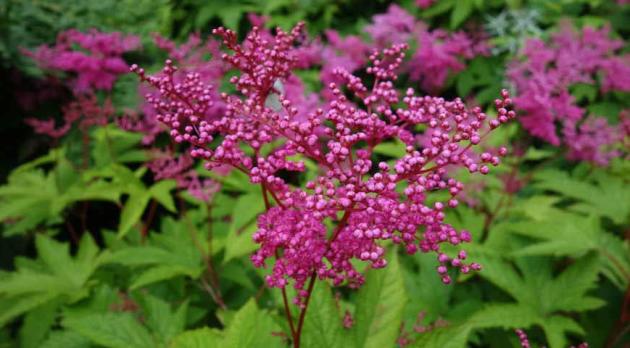
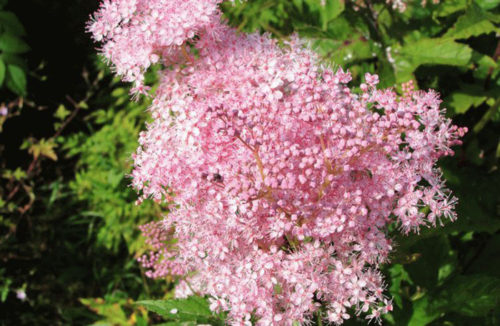
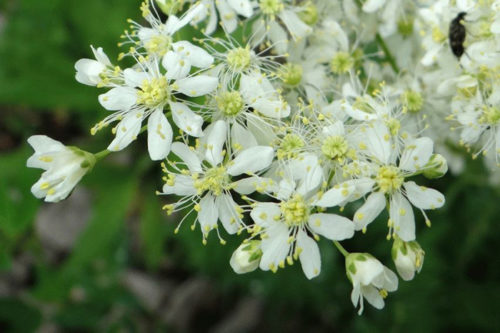
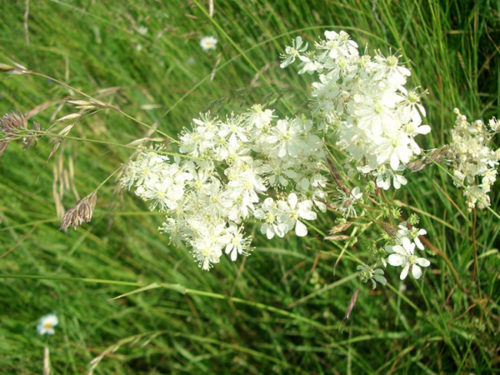
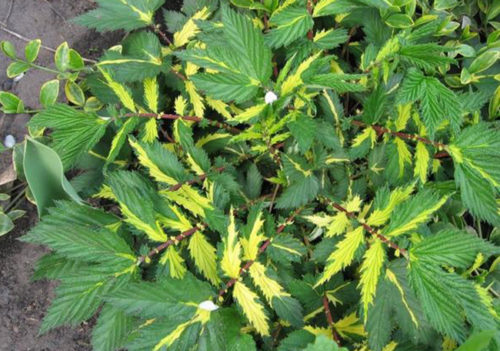
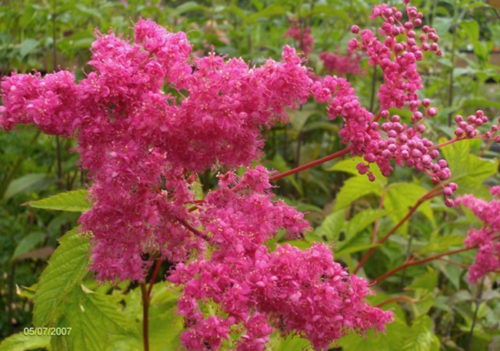

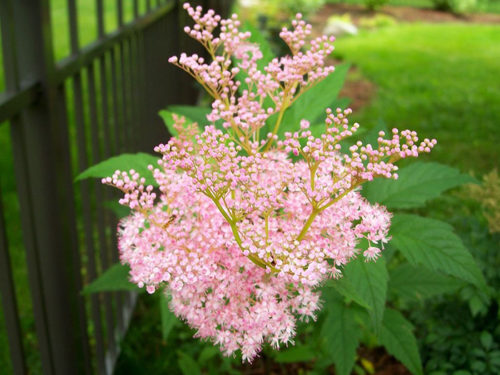
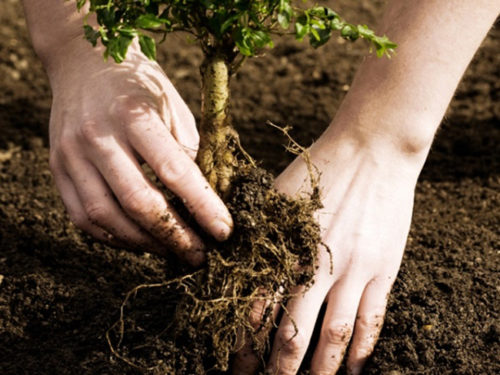
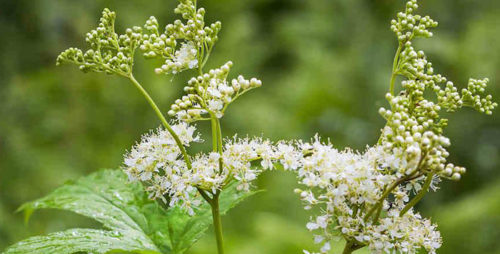
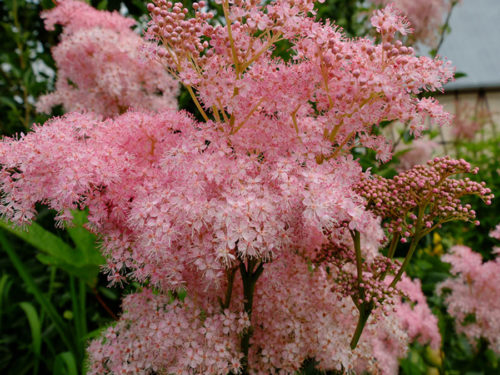
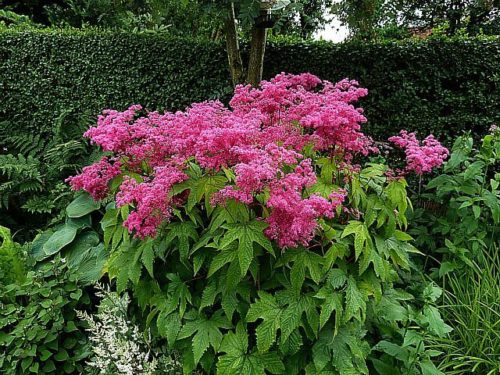
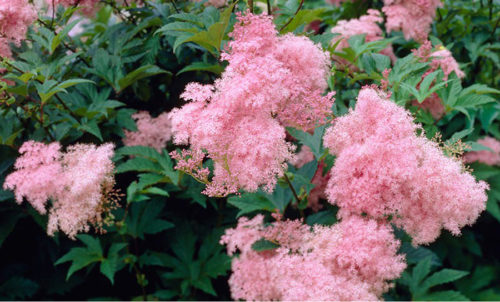
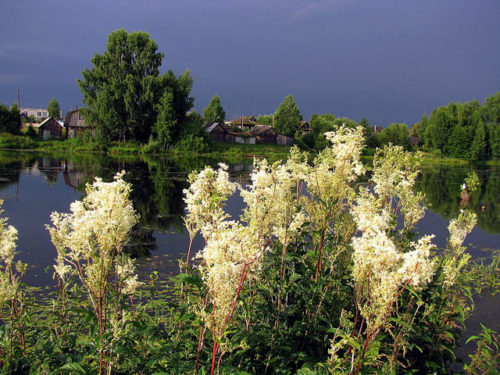












 Start a discussion ...
Start a discussion ...